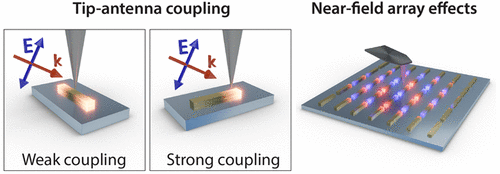当前位置:
X-MOL 学术
›
ACS Photonics
›
论文详情
Our official English website, www.x-mol.net, welcomes your
feedback! (Note: you will need to create a separate account there.)
Tip Coupling and Array Effects of Gold Nanoantennas in Near-Field Microscopy
ACS Photonics ( IF 6.5 ) Pub Date : 2021-10-14 , DOI: 10.1021/acsphotonics.1c00744 Rebecca Büchner 1 , Thomas Weber 1 , Lucca Kühner 1 , Stefan A. Maier 1, 2 , Andreas Tittl 1
ACS Photonics ( IF 6.5 ) Pub Date : 2021-10-14 , DOI: 10.1021/acsphotonics.1c00744 Rebecca Büchner 1 , Thomas Weber 1 , Lucca Kühner 1 , Stefan A. Maier 1, 2 , Andreas Tittl 1
Affiliation

|
Scattering-type scanning near-field optical microscopy (s-SNOM) is one of the predominant techniques for the nanoscale characterization of optical properties. The optical response of nanoantennas in s-SNOM is highly sensitive to their environment, including influences of the probing tip or neighboring resonators. Dielectric tips are commonly employed to minimize tip-related perturbations, although they provide a comparatively weak scattering signal. Here we show that when using metallic tips, it is possible to select between distinct weak and strong tip–antenna coupling regimes by careful tailoring of the illumination conditions and resonator orientation. This enables the use of highly scattering metallic instead of dielectric tips for mapping plasmonic modes with comparatively higher signal strengths. This is a particular advantage for the retrieval of near-field spectra, which simultaneously require high near-field signals and unperturbed field patterns. We leverage our approach to analyze the collective effects of nanoantenna arrays, phenomena that are well understood in the optical far-field but have not been extensively studied in the near-field. Probing the dependence of the optical response on the array field size, we identify three regimes: the single rod regime, the intermediate regime, and the array-like regime. We show that these array effects give rise to characteristic spectral features originating from a complex interplay of radiative coupling and plasmon hybridization. These results provide evidence that long-range interactions of antennas also influence the local optical response that is probed in s-SNOM and demonstrate how collective resonances emerge from single building blocks, providing guidelines for optimized array designs for near- and far-field applications.
中文翻译:

金纳米天线在近场显微镜中的尖端耦合和阵列效应
散射型扫描近场光学显微镜 (s-SNOM) 是用于光学特性纳米级表征的主要技术之一。s-SNOM 中纳米天线的光学响应对其环境高度敏感,包括探测尖端或相邻谐振器的影响。电介质尖端通常用于最小化与尖端相关的扰动,尽管它们提供相对较弱的散射信号。在这里,我们表明,当使用金属尖端时,可以通过仔细调整照明条件和谐振器方向,在不同的弱和强尖端-天线耦合机制之间进行选择。这使得能够使用高度散射的金属而不是电介质尖端来映射具有相对较高信号强度的等离子体模式。这是检索近场光谱的一个特殊优势,它同时需要高近场信号和未受干扰的场模式。我们利用我们的方法来分析纳米天线阵列的集体效应,这种现象在光学远场中很容易理解,但在近场中尚未得到广泛研究。探索光学响应对阵列场大小的依赖性,我们确定了三种状态:单杆状态、中间状态和类阵列状态。我们表明,这些阵列效应产生源自辐射耦合和等离子体杂交的复杂相互作用的特征光谱特征。
更新日期:2021-12-15
中文翻译:

金纳米天线在近场显微镜中的尖端耦合和阵列效应
散射型扫描近场光学显微镜 (s-SNOM) 是用于光学特性纳米级表征的主要技术之一。s-SNOM 中纳米天线的光学响应对其环境高度敏感,包括探测尖端或相邻谐振器的影响。电介质尖端通常用于最小化与尖端相关的扰动,尽管它们提供相对较弱的散射信号。在这里,我们表明,当使用金属尖端时,可以通过仔细调整照明条件和谐振器方向,在不同的弱和强尖端-天线耦合机制之间进行选择。这使得能够使用高度散射的金属而不是电介质尖端来映射具有相对较高信号强度的等离子体模式。这是检索近场光谱的一个特殊优势,它同时需要高近场信号和未受干扰的场模式。我们利用我们的方法来分析纳米天线阵列的集体效应,这种现象在光学远场中很容易理解,但在近场中尚未得到广泛研究。探索光学响应对阵列场大小的依赖性,我们确定了三种状态:单杆状态、中间状态和类阵列状态。我们表明,这些阵列效应产生源自辐射耦合和等离子体杂交的复杂相互作用的特征光谱特征。











































 京公网安备 11010802027423号
京公网安备 11010802027423号